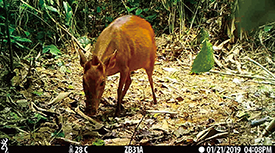Master Techniques from Japan to the World 4
Building a Forest Resources Management Model that Reconciles Tropical Rainforest Conservation with the Lives of Indigenous Peoples
—Improving the lives of people living in the forest through joint research with Cameroon—

Placing a camera trap for a wildlife survey while camping together with local assistants in the tropical rainforest (Photo: COMECA Project)

A Peters’s duiker, one of the main hunting targets in the project site, captured by a camera trap placed in the forest (Photo: COMECA Project)
Southeast Cameroon is covered by tropical rainforests with high biodiversity. However, sustaining these rainforest ecosystems has been increasingly difficult since the 1990s due to deforestation for timber exports and overhunting of ivory and bushmeat. Therefore, the Government of Cameroon has established several natural reserves where hunting and timber exploitation are prohibited. Meanwhile, in this region, an ethnic group called the Baka has practiced hunting and gathering, coexisting with nature since long ago. Ironically, the government’s conservation policy has deemed Baka’s hunting activities for subsistence illegal, making it difficult for them to sustain their traditional lifestyle.
Against this backdrop, researchers from Japan, led by Dr. YASUOKA Hirokazu, Associate Professor at the Center for African Area Studies of Kyoto University, formed an international joint research team with Cameroonian researchers from the Institute of Agricultural Research for Development (IRAD) and other institutes. Dr. Yasuoka has long conducted interdisciplinary research on the ecology of people in the Congo Basin. The team commenced the “Project of Co-creation of Innovative Forest Resources Management Combining Ecological Methods and Indigenous Knowledge (COMECA)” based on the framework of the Science and Technology Research Partnership for Sustainable Development (SATREPS) program.
Under this project, the team conducts ecological surveys of wildlife in and around the national parks of southeastern Cameroon. Moreover, the researchers combine the scientific results with the indigenous knowledge of local people (experience-based knowledge, skills and practice related to their land and flora and fauna, which are often inappropriate to generalize in a scientific manner). In this way, the team will prepare proposals and a roadmap for the government to sustainably use wildlife and non-timber forest products (NTFP).*1 It also plans to cooperate with IRAD, local peoples and others to develop processing methods for Irvingia nuts and other NTFPs to promote alternative means for income.
“To build relationships of trust and to work together for forest conservation, it is necessary to create a system where residents are proactively involved in the use and management of forest resources,” said Dr. Yasuoka. “We aim to establish a management model that integrates indigenous and scientific knowledge to build a bridge between conservation authorities and local people. This model will enable the residents to continue their livelihood customs with wild meat while maintaining biodiversity.”
Dr. HONGO Shun, a Program-specific Researcher of the COMECA Project, has been conducting fieldwork since 2018. Using motion-triggered camera traps to record wild animals, he estimates the population density of hunted animals and develops a system for monitoring their abundance. “Together with local people,” Dr. Hongo said, “we will explore a method where they can monitor faunal resources by themselves employing their indigenous knowledge.” He also supervises researchers and students at counterpart institutions in Cameroon.
“The Congo Basin has the world’s second-largest tropical rainforests after the Amazon, and a variety of people live in the area besides hunter-gatherers. Although the COVID-19 pandemic has hampered the project’s progress, we intend to make steady advances to improve the lives of the people in the forest and the biodiversity conservation,” said Dr. Yasuoka.
Combining science and indigenous knowledge, the research team of Japan and Cameroon is now building a forest resource management model for sustainable use of the Congo Basin tropical rainforests, together with local people.
*1 A variety of products other than timber that are harvested in forest regions, such as nuts, mushrooms, and berries.
<< Previous Page
Main Text | Reference Statistics | Stories from the Field | Master Techniques from Japan to the World | ODA Topics
